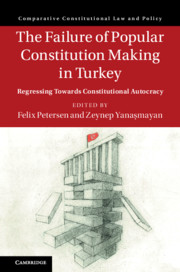Book contents
- The Failure of Popular Constitution Making in Turkey
- Comparative Constitutional Law and Policy
- The Failure of Popular Constitution Making in Turkey
- Copyright page
- Contents
- Figures
- Contributors
- Part I Introduction
- Introduction
- 1 Explaining the Failure of Popular Constitution Making in Turkey (2011–2013)
- Part II Contextualizing Constitution Making in Turkey
- Part III Debating and Drafting the Constitution in 2011–2013
- Appendices
- Index
Introduction
from Part I - Introduction
Published online by Cambridge University Press: 19 December 2019
- The Failure of Popular Constitution Making in Turkey
- Comparative Constitutional Law and Policy
- The Failure of Popular Constitution Making in Turkey
- Copyright page
- Contents
- Figures
- Contributors
- Part I Introduction
- Introduction
- 1 Explaining the Failure of Popular Constitution Making in Turkey (2011–2013)
- Part II Contextualizing Constitution Making in Turkey
- Part III Debating and Drafting the Constitution in 2011–2013
- Appendices
- Index
Summary
With the fall of the Iron Curtain and the dissolution of the Soviet Union, liberalism appeared to become the only game in town. The political cataclysms of the late 1980s triggered a wave of scholarship in political science and constitutional law on the prospects of political change. In particular, constitutionalism, constitution making, and constitutional politics became dominant topics accompanying the debate on transformations in the socialist states of Eastern and Central Europe, and later South Africa and Latin American countries. The enthusiasm of the historical moment made most contributions to this debate focus on the conditions that make transformation (i.e., constitutionalization or re-constitutionalization) successful. As most transitions were from some sort of authoritarianism or autocracy to democracy, the question at the heart of scholarship has been how to successfully constitutionalize a liberal democratic state.
- Type
- Chapter
- Information
- The Failure of Popular Constitution Making in TurkeyRegressing Towards Constitutional Autocracy, pp. 3 - 20Publisher: Cambridge University PressPrint publication year: 2020
- 1
- Cited by

